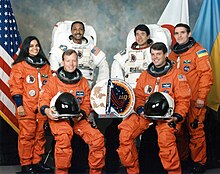STS-87

Columbia launches on STS-87
|
|
| Mission type | Microgravity research Technology development |
|---|---|
| Operator | NASA |
| COSPAR ID | 1997-073A |
| SATCAT no. | 25061 |
| Mission duration | 15 days, 16 hours, 35 minutes, 01 seconds |
| Distance travelled | 10,500,000 kilometres (6,500,000 mi) |
| Spacecraft properties | |
| Spacecraft | Space Shuttle Columbia |
| Landing mass | 102,717 kilograms (226,452 lb) |
| Payload mass | 4,451 kilograms (9,813 lb) |
| Crew | |
| Crew size | 6 |
| Members |
Kevin R. Kregel Steven W. Lindsey Winston E. Scott Kalpana Chawla Takao Doi Leonid Kadenyuk |
| Start of mission | |
| Launch date | 19 November 1997, 19:46 UTC |
| Launch site | Kennedy LC-39B |
| End of mission | |
| Landing date | 5 December 1997, 12:20 UTC |
| Landing site | Kennedy SLF Runway 33 |
| Orbital parameters | |
| Reference system | Geocentric |
| Regime | Low Earth |
| Perigee | 273 kilometres (170 mi) |
| Apogee | 279 kilometres (173 mi) |
| Inclination | 28.45 degrees |
| Period | 90.0 min |
 Left to right - in orange: Chawla, Lindsey, Kregel, Kadenyuk; in white: Scott, Doi |
|
STS-87 was a Space Shuttle mission launched from Launch Complex 39B of the Kennedy Space Center on 19 November 1997. It was the 88th flight of the Space Shuttle, and the 24th flight of Columbia. The mission goals were to conduct experiments using the United States Microgravity Payload (USMP-4), conduct two EVAs, and to deploy the SPARTAN-201 experiment. This mission marked the first time an EVA was performed from Columbia. An EVA from Columbia was originally planned for STS-5 in 1982, but was cancelled due to spacesuit problems. It also marked the first EVA conducted by a Japanese astronaut, Takao Doi.
STS-87 flew the United States Microgravity Payload (USMP-4), Spartan-201, Orbital Acceleration Research Experiment (OARE), tEVA Demonstration Flight Test 5 (EDFT-05), the Shuttle Ozone Limb Sending Experiment (SOLSE), the Loop Heat Pipe (LHP), the Sodium Sulfur Battery Experiment (NaSBE), the Turbulent GAS Jet Diffusion (G-744) experiment and the Autonomous EVA Robotic Camera/Sprint (AERCam Sprint) experiment. Mid-deck experiments included the Middeck Glovebox Payload (MGBX) and the Collaborative Ukrainian Experiment (CUE).
The United States Microgravity Payload (USMP-4) is a Spacelab project managed by Marshall Space Flight Center, Huntsville, Alabama. The complement of microgravity research experiments is divided between two Mission-Peculiar Experiment Support Structures (MPESS) in the payload bay. The extended mission capability offered by the Extended Duration Orbiter (EDO) kit provides an opportunity for additional science gathering time.
...
Wikipedia

